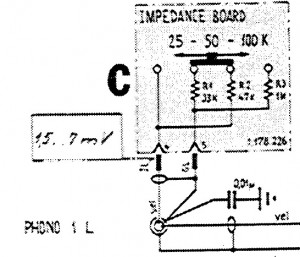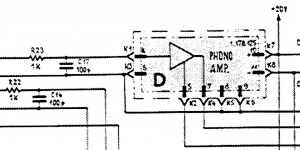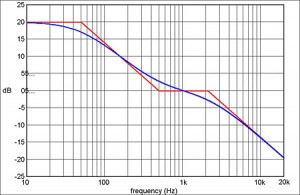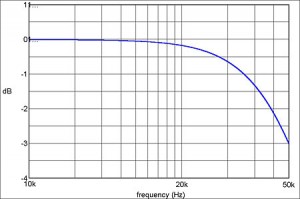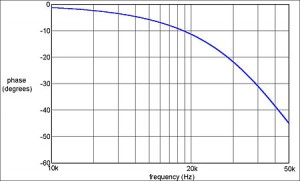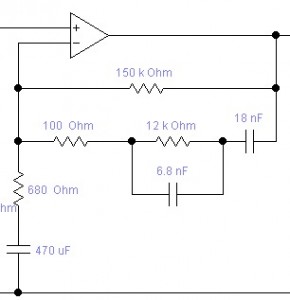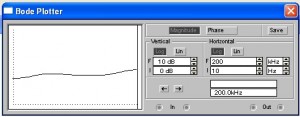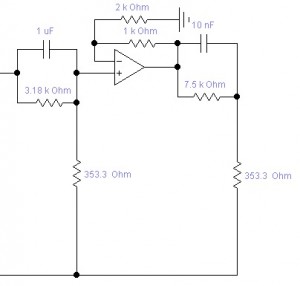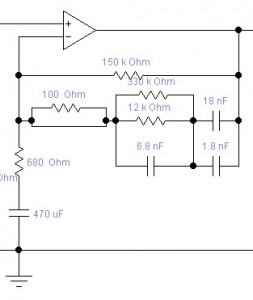Revox B750MK-II is very interesting amplifier. It integrates nice RIAA EQ preamp for MM cartridges. After changing all of the capacitors and transistors, its sound is very impressive. First of all it is a current feedback amplifier. The power amps sound pretty at all. This post is purposed to the RIAA EQ of the amplifier.
First of all I was impressed of the linearity of the RIAA corrector. I used one Shure M95DEM cartridge, which impresses me with the good frequency performance on this MM preamp. The M95 is not so good at all. It has high high frequency loses. The inductance of the cartridge is about 650 mH and is high at all. The resistance of the cartridge is also very high and is about 1.55 kohm. That produces high thermal noise inside the cartridge and reduce the overall signal to noise ratio. I was surprised of the linearity of this cartridge using the 100k input impedance setting (it is switchable between 25k, 47k and 100k).
The answers came with the first view of the schematics. The input load capacitance is about 100pF, which compensate the loss in the 20kHz range. The resonance with the cartridge inductance is exactly 20kHz and the load impedance of 100k allow to compensate the dull sound signature of the cartridge. The resonance is not so aggressive because of the additional serial resistance of 1 kom between the capacitor and the cartridge. The summing serial resistance with the cartridge then comes about 2.55k, which makes the Q factor not so high. All that facts confirms that M95DEM suits perfectly to the B750 MM input.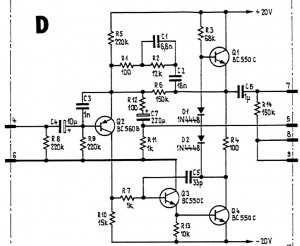 I decided to check the overall frequency response of the RIAA corrector. The schematic is very interesting. The loopback circuit contains two capacitors and 3 resistors. On the first look, it is strange and the time constants do not follow the standard ones. Maybe everyone knows that the RIAA EQ contain 3 main time constants. These time constants (3180, 318, and 75 microseconds) and their respective corner frequencies (50.05, 500.5, and 2,122Hz) are depicted in the red trace of figure, which shows the straight-line approximation of the RIAA deemphasis (ie, replay) curve, alongside the actual curve (blue).
I decided to check the overall frequency response of the RIAA corrector. The schematic is very interesting. The loopback circuit contains two capacitors and 3 resistors. On the first look, it is strange and the time constants do not follow the standard ones. Maybe everyone knows that the RIAA EQ contain 3 main time constants. These time constants (3180, 318, and 75 microseconds) and their respective corner frequencies (50.05, 500.5, and 2,122Hz) are depicted in the red trace of figure, which shows the straight-line approximation of the RIAA deemphasis (ie, replay) curve, alongside the actual curve (blue).
Note that the latter is a mirror image of the preemphasis curve in figure, so that the two are exactly complementary: applying the deemphasis on replay cancels the effect of the preemphasis applied during cutting, to leave a flat response overall. The new cutting machines use a new approach that reduces the components above 50 kHz. This concern over the high-frequency phase performance of disc-equalization circuits brings us nicely to a more recent development: compensation for the “Neumann ultrasonic time constant.” (I have also seen this referred to as the “Neumann 4th pole,” which is inaccurate terminology for reasons explained down.) It originates, as far as I have been able to establish, in a book about tube amplifier design published in 1995 by Allen Wright, Australian founder of Vacuum State Electronics. In a section dealing with RIAA equalization, Wright pointed out that the inexorable rise of the RIAA preemphasis curve beyond 20 kHz was not something that could be maintained in practice, otherwise it would threaten damage to the cutting head. So the manufacturers of disc-cutting amplifiers curtail the amplification at ultrasonic frequencies, typically by incorporating an additional time constant at around 50 kHz. Wright wrote that this should be compensated for in the replay equalization, as shown in the figure.
This idea was later picked up by Jim Hagerman, who wrote about it in Audio Electronics. Since then, a number of preamp manufacturers, including AQVOX, darTZeel, and Whest Audio, have joined Vacuum State Electronics in amending their RIAA replay equalization to take account of this factor. Neumann’s name became attached to the correction because its lathes—on which a great many of the world’s vinyl records have been cut down the decades—have been reported to incorporate an additional record EQ time constant of 3.18 µs (50.05 kHz). As we will see, this isn’t correct—but for the moment, let’s assume that it is.
Figure above shows that implementing this correction makes little difference to frequency response within the audible range, the disparity being only 0.17dB at 10kHz, and just 0.64dB at 20kHz. So justification for this correction has sometimes rested more on the effects of in-band phase distortion. Let’s look more closely at this, because claims about phase are all too often naive and misleading.
Some want to use the 3.18uS correction in the playback EQ, some do not like this correction. I decided to make simulation of the Revox B750MK-II RIAA. The next schematic shows the simulation circuit, which is close to the original one. The aim is to simulate the negative feedback performance.
The results are very impressive. If we take the 1 kHz as a reference frequency, there is +0.13dB peak at 245 Hz. Then starting to roll off at 100 Hz low frequency. The 20 Hz level is -0.5dB. The 20 kHz level is +0.035 dB (compared to the 1 kHz reference). The 200kHz level is about +0.7dB. The phase variation is between +2.9 degree and -0.5 degrees in the full frequency range (10Hz-200kHz).
It seems, that it takes into account this phase difference at the high frequencies. First of all, I used a reverse corrector, which is put at the output of the playback EQ. The impedance dependence is taking into account. The reverse EQ uses 3180, 318, 75 and 3.18 uS for the time constants.
Then I try to optimize the values for better (flat) frequency and phase response. Chang some values I get more linear response.

I put another 1.8nF in parallel to C2 and another 330k in parallel to the R2. Also shorted the R1 and R11. The last one disables the phono sensitivity regulator. The final change is to put fixed value of 680 ohms for the R12. That ensures no change in frequency response, when changing the sensitivity regulator. The final results can be seen from the frequency range of 10Hz up to 200kHz.
References:

